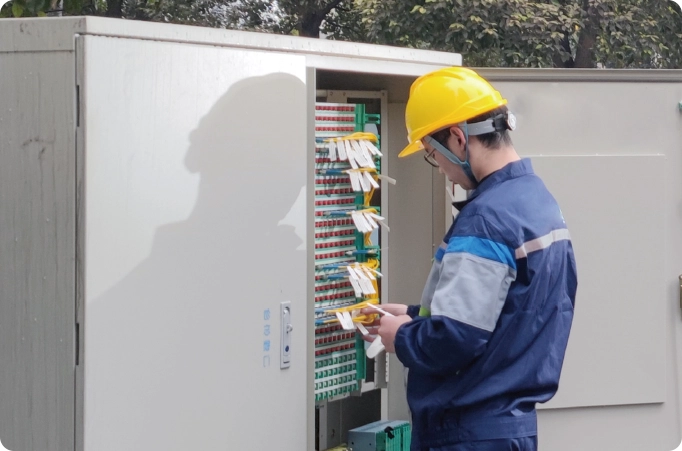Thermal Transfer vs Direct Thermal: Which is More Suitable for Fiber Optic Labels?
In scenarios such as optical fiber communications, data centers, and outdoor communication base stations, optical fiber labels play an essential role in the maintenance of equipment and troubleshooting. But, a lot of users are faced with the decision of the choice among “Thermal Transfer” and “Direct Thermal”. Selecting the right technology ensures durable and reliable labels, while the wrong choice can lead to blurred labels, maintenance errors, and even increased costs. This article will start from the specific needs of fiber optic labeling, comprehensively compare the differences between the two technologies, help you accurately match the suitable scenarios, and avoid pitfalls in selection.

Why Do Fiber Optic Labels “Care” About Printing Technology?
Fiber optic labels differ from regular paper labels. They attach long-term to fiber sleeves, jumpers, or patch panels and endure harsher environments.
Key requirements include long-term weather resistance (withstanding oil/dust in indoor rooms, wind/rain/UV outdoors, and chemicals in industry); wear resistance (to avoid scratches during maintenance that blur text and cause fiber misidentification or outages); and high-temperature stability (preventing fading from heat generated by fiber equipment, which would hinder troubleshooting).
Choosing the wrong printing tech has unexpected consequences—e.g., outdoor labels fading in 3 months, making staff spend hours locating fibers. Repeated replacement wastes consumables and risks damaging fiber interfaces. Thus, identifying whether heat transfer or thermal printing suits fiber labeling is vital for cutting maintenance costs and boosting efficiency.
The Core Differences Between Thermal Transfer and Direct Thermal
To choose the right tech for fiber optic labeling, clarify core differences between thermal transfer and direct thermal—from working principles to costs, all impact label effectiveness.
1. Working Principle
Thermal Transfer: Relies on thermal paper’s chemical coating to change color via the printer’s hot head. Uses only thermal paper (no extra ribbons), easy to operate with fast printing. But flaws exist: label clarity/durability depend fully on thermal paper quality; it can’t print on ordinary fiber sleeves/PVC, limited to dedicated thermal labels.
Direct Thermal: Uses the printer’s heating element to melt/sublime ink on a dedicated ribbon, transferring it to substrates (fiber sleeves, PET/PVC labels). Needs “ribbon + substrate” but has strong adaptability—prints stably on smooth/rough labels, with ink that stays attached.
2. Key Performance Parameters
The requirements of fiber optic labels for “weather resistance, wear resistance, and durability” directly correspond to the performance parameters of the technology. The following table clearly compares the core indicators of the two technologies to help you make a quick judgment:
| Performance Dimension | Direct Thermal | Thermal Transfer |
| Weather Resistance | -20℃~60℃, prone to fading (fails in high temp/UV) | -40℃~150℃, stable (resists UV/rain/chemicals) |
| Wear Resistance | Low; surface color layer scratches easily (text peels off) | High; ink penetrates/adheres firmly (withstands frequent handling) |
| Durability | 1-3 years (easily affected by humidity/oil) | 5-10 years (remains clear without frequent replacement) |
3. Consumable Cost
Direct thermal lures users with low initial costs (30%-50% cheaper per sheet than thermal transfer’s “ribbon + label”). But long-term, thermal transfer is more cost-effective: direct thermal labels need replacing every 1-3 years (high annual costs for large fiber counts), while thermal transfer labels last 5-10 years, cutting 20%-40% of 5-year total costs—ideal for large-scale fiber setups.
Adaptability in Different Fiber Optic Scenarios
There’s no absolutely “good” tech for fiber optic labeling—only “suitable” ones. Optimal selection depends on the fiber’s installation environment and service life.
1. Indoor Scenarios (Computer Rooms, Data Centers, Enterprise Weak Current Rooms)
Indoor environments are stable (18℃~25℃, no wind/rain/UV) but may have oil/dust, with frequent fiber maintenance.
Direct Thermal Adaptability: Medium
It works for “short-term temporary labels” (e.g., fiber jumpers adjusted within 1 year) due to low cost and fast printing. But high-quality waterproof thermal labels are a must (to avoid blurring from AC condensation/water stains), and inspections every 1-2 years are needed to replace faded labels.
Thermal Transfer Adaptability: High
Ideal for “long-term fixed fibers” (e.g., data center backbone fibers). It prints directly on fiber sleeves/PVC labels, resists oil and scratches, stays clear during frequent maintenance, and cuts long-term costs by avoiding frequent replacements.
Conclusion: Prioritize heat transfer; thermal printing is acceptable for short-term, budget-limited cases (with regular checks).

2. Outdoor Scenarios (Communication Base Stations, Underground Pipelines, Park Outdoor Fibers)
Outdoor environments are harsh (high temp, heavy rain, UV, soil corrosion), a tough test for labeling tech.
Direct Thermal Adaptability: Low
Even with waterproof labels, summer temps over 70℃ accelerate coating aging (fading in 1-3 months). Rain/UV worsen damage, making labels unrecognizable and forcing time-consuming fiber testing.
Thermal Transfer Adaptability: High
Paired with “outdoor-specific ribbons + weather-resistant labels,” its ink resists UV/rain/corrosion, stays stable at -40℃~150℃, and lasts over 5 years (e.g., base station labels need no replacement for 3 years).
Conclusion: Heat transfer is mandatory to avoid maintenance delays and extra labor costs.
3. Special Scenarios (Industrial Control, Medical Equipment, Military Fibers)
These demand high label compliance and extreme environment resistance (e.g., industrial oil/chemicals, medical sterility/disinfection).
Direct Thermal Adaptability: Almost Inapplicable
Its coating fades quickly with industrial chemicals, is damaged by medical disinfectants, and fails industry certifications (e.g., FDA, CE).
Thermal Transfer Adaptability: High
With “special ribbons” (chemical-resistant/sterile), its labels meet certifications, resist oil/disinfectants, and suit strict needs (e.g., medical labels withstand repeated alcohol disinfection).
Conclusion: Heat transfer is the only choice for compliance and stability.
3 Steps to Determine the Right Fiber Optic Labeling Technology
If unsure which tech to choose after scenario analysis, follow these 3 quick steps:
First, check the scenario for basic tech fit
For outdoor (e.g., base stations, pipelines) or special scenarios (e.g., industrial workshops, medical equipment), choose thermal transfer directly. Harsh conditions (high temp, UV, chemicals) exceed direct thermal limits, and thermal transfer with dedicated ribbons meets stability/compliance needs. For indoor use (e.g., server rooms), move to step 2.
Then evaluate lifespan to define boundaries
Indoors, direct thermal works for short-term use (fibers adjusted/replaced in 1-3 years, e.g., temp test fibers) for low cost/fast printing—use waterproof labels and check every 1-2 years. For long-term use (fibers fixed over 5 years), thermal transfer is a must, cutting maintenance costs.
Finally calculate cost to verify
Direct thermal is better for <50 fibers & <3 years (low initial cost). Thermal Transfer is cheaper for >50 fibers & >3 years, saving 20%-40% over 5 years.
Conclusion
In conclusion, heat transfer suits 90% of fiber optic labeling scenarios. It meets strict demands in various settings, with low long – term costs. For short – term indoor fibers, thermal printing can be considered but requires regular checks.
For thermal transfer needs, the makeID label printers are excellent choice. It offers sharp prints, uses waterproof tapes, and has multiple options. Compatible with various devices, it ensures durable and clear labels for your fiber optic labeling tasks.

